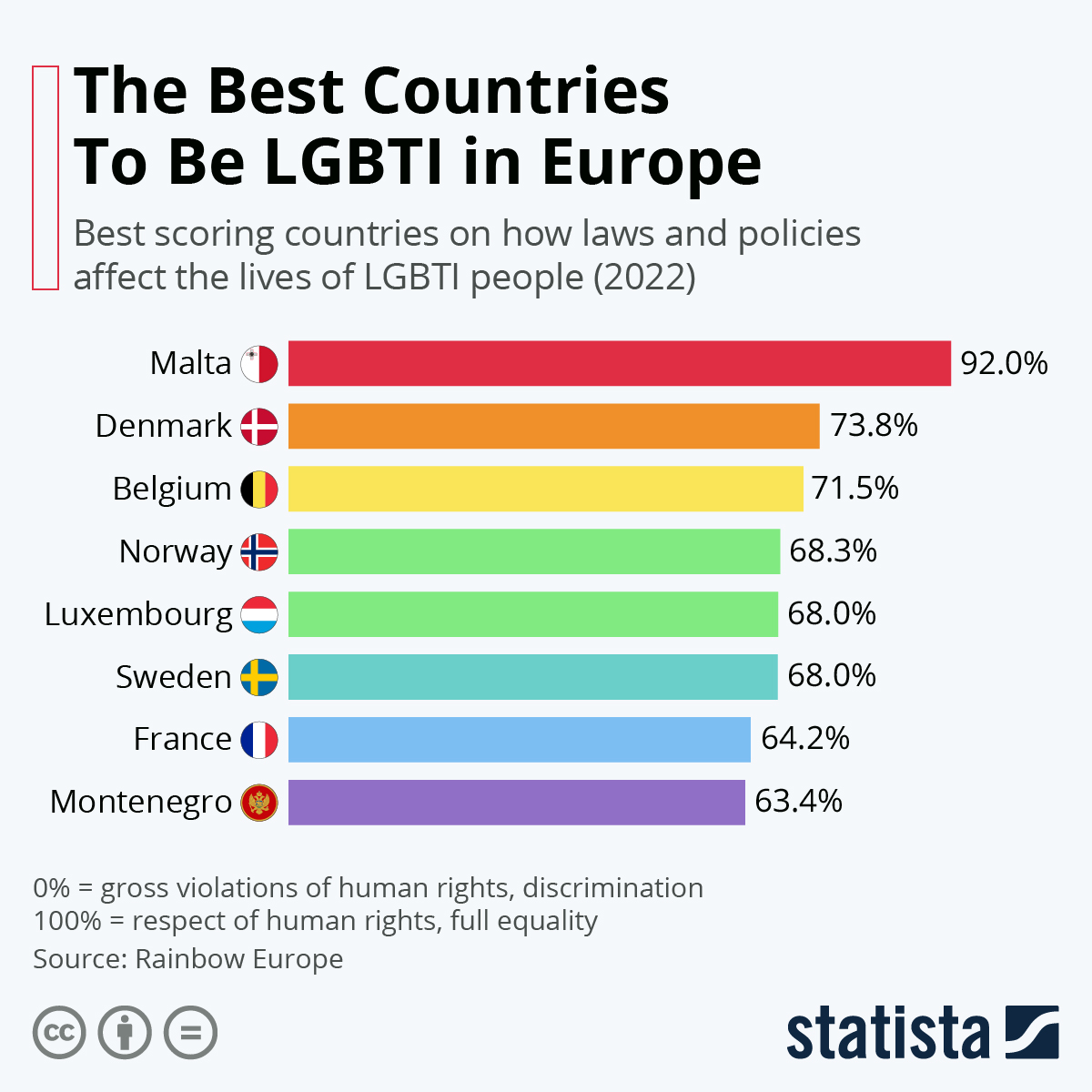LGBTQ+ Europe - Statistics & Facts
While it is important to acknowlege the progress that has been made towards an LGBTQ-friendly and inclusive Europe, there is a long way to go before homophobia and prejudice against the LGBTQ+ community is eradicated from the continent. Nevertheless, cities and regions across Europe have become renowned for their queer-friendly environments and are migration and tourism destinations for LGBTQ+ people from across the world. Additionally, Europride, a pan-European pride festival, has taken place in different cities across the continent since 1992, aiming to unite the LGBTQ+ community in the continent across national, cultural, and linguistic boundaries.

LGBTQ rights movements in Europe
While LGBTQ people have always existed Europe, the movement for gay rights only began to develop at the end of the nineteenth century. One of the most famous early gay rights activists was Magnus Hirschfeld, a scientist based in Berlin, Germany, who founded the Scientific-Humanitarian Committee in 1897 to advocate for LGBTQ+ rights and who later pioneered the study of sexuality at the Institut für Sexualwissenschaft (Institute for Sex Research). Similar movements began to develop in countries across western Europe such as the UK, the Netherlands, and particularly in France, where homosexuality was decriminalized in 1933, second only to the Soviet Union, which had done so in 1917.The modern gay rights movement, however, developed in Europe during the latter half of the twentieth century, with many groups being inspired by the movement that had already developed in the United States during the 1960s, with the 1969 Stonewall Riots in New York being a moment which inspired many LGBTQ+ activists. In the 1970s, the first gay pride parades and festivals took place in London, Amsterdam, and Berlin, with these being repeated annually since. Throughout the final years of the twentieth century, LGBTQ+ activists won many legal victories in Europe, repealing homophobic laws, winning anti-discrimination protections, and in some cases winning the rights to equal marriage and adoption.
Europe's most LGBTQ-friendly countries and cities
Europe is home to some of the most gay-friendly cities on the planet, with Amsterdam, Berlin, and Madrid hosting pride celebrations which are world-renowned. The European cities which rank as being the most open to their LGBTQ citizens are, however,Rekjavik, Valletta and Groningen and Luxembourg, with over 90 percent of citizens in these cities responding that they are good places to live for gay, lesbian, and trans people. In general, the Nordic countries (Denmark, Finland, Iceland, Norway, and Sweden) and the Benelux countries (Belgium, Netherlands, Luxembourg) have tended to be the leaders in LGBTQ+ rights in Europe, while other countries in western and southern Europe tend to also be mostly gay-friendly. Perhaps surprisingly, the small island state of Malta has become the European champion of LGBTQ+ rights during the 2010s, as the country legalized gay marriage, banned anti-LGBTQ+ practices such as conversion therapy, and has recently bolstered the rights of trans and intersex people in the country.Prominent gay, lesbian, and trans Europeans
Members of the European LGBTQ+ community have made important contributions to all facets of life on the continent, including in science, the arts, sports, and politics. Some examples of prominent LGBTQ Europeans include Alan Turing (UK), widely considered the father of modern computing, Marcel Proust (France), one of the most renowned novelists of the twentieth century, Pedro Almodóvar (Spain), one of the continent's most celebrated contemporary filmmakers, and Martina Navratilova (Czechia), considered one of the greatest tennis players of all times, among countless others.Europe has become a leader in electing LGBTQ+ people to political office since the turn of the twenty-first century, with Klaus Wowereit (Berlin) and Bertrand Delanoë (Paris) both becoming the first openly-gay mayors of major international cities worldwide in 2001. Europe remains the only continent to have had openly gay or lesbian heads of government, with Jóhanna Sigurðardóttir of Iceland becoming the first in 2009. Currently there are three LGBTQ+ prime ministers in Europe - Xavier Bettel of Luxembourg, Leo Varadkar of Ireland, and Ana Brnabić of Serbia.

Homophobia and discrimination
In spite of the improved situation for many LGBTQ people in Europe in the twenty-first century, there are still certain regions and countries where queer people routinely experience discrimination, both in their legal status and in their everyday lives. The worst countries for LGBTQ+ rights in Europe are all located in central, eastern or south-eastern Europe, with Russia, Poland, Hungary, and Turkey being particularly renowned for the homophobic stances taken by their governments. These negative attitudes may result in legal discrimination against homosexual, transgender, or intersex people, such as through not being allowed to marry, adopt, or have their gender identity recognized.In more extreme cases, discrimination leads to physical assault on LGBTQ+ people, with 11 percent of EU citizens reporting having experienced a gender- or sexuality-based assault in the last five years. This number was twice as high for intersex people, while 17 percent of transgender people had also experienced an assault. The countries with the worst track record in terms of violent assault on LGBTQ+ people were in central-eastern and south-eastern Europe, with North Macedonia, Serbia, and Poland being the three with the most respondents indicating they had been assaulted. Whilst in many regions of Europe the situation of LGBTQ+ people has vastly improved over the preceding decades, the resurgence of traditionalist religious values, whether Catholic, Orthodox Christian, or Islamic, has led to a surge in homophobia, spurred on by the election of right-wing nationalist leaders.








































